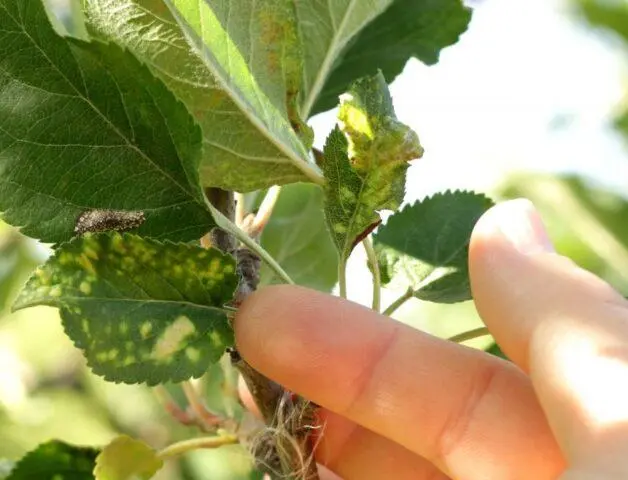Contents
Apple chlorosis is a disease that disrupts the formation of chlorophyll in the leaves and reduces photosynthesis. A number of reasons can provoke its development. But if the problem is identified in a timely manner and measures are taken to eliminate it, then the tree is quickly restored without losing productivity. Therefore, every gardener should be able to determine apple chlorosis at an early stage of development, as well as know the possible causes of its appearance.
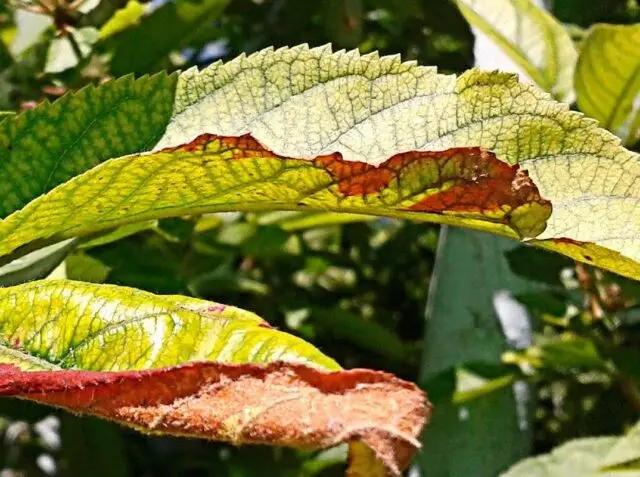
With chlorosis, the leaves acquire an unnatural light color.
Description of apple chlorosis with a photo
This disease occurs against the background of a violation of metabolic processes in the tissues of the apple tree. This is reflected in the appearance of the tree, primarily on the leaves. The plates noticeably brighten, but the veins remain a rich green hue. Subsequently, black dots appear on the affected areas.
Also a sign of chlorosis is a decrease in the size of young leaves. The edges of the plates curl, and the shoots dry out. Chlorosis negatively affects flowers, ovaries and fruits. With this disease, they are deformed. Apples lose their presentation, and their taste is reduced.
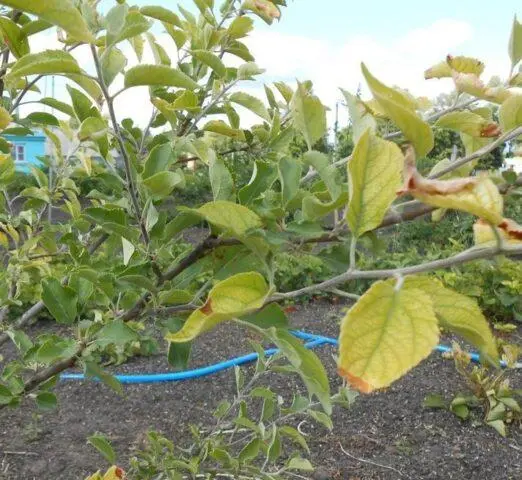
In this case, the disease disrupts the development of not only the crown, but also the root of the tree.
Causes of apple chlorosis
Apple chlorosis is viral and physiological. In the first case, the disease is carried by pests. The virus can also be transmitted through young seedlings. And when buying, you should carefully examine them, as well as pay attention to the state of the root system.
In the second case, the reason is a violation of the rules for caring for an apple tree, as a result of which the shrub lacks nutrients. This happens in the absence of timely top dressing and the inability of the roots to absorb them from the soil.
Physiological chlorosis occurs against the background of a lack of such elements:
- Gland. The disease develops with a lack of this component in the soil, which provokes an excess of lime. As a result, the alkaline reaction of the soil is more than 7 pH. This turns the iron into an inaccessible form for plants. This type of chlorosis occurs in spring and in the first half of summer. It manifests itself by yellowing of the leaves, which begins with the top of the shoots. In the absence of treatment, the frost resistance of the apple tree decreases, the fruits crumble.
- Boron, magnesium, manganese. With this type of disease, the plates between the veins lose their shade. Moreover, the clarification of the leaves occurs unevenly. In addition, the development of the seedling slows down, the fruits decrease in size, and their color turns pale.
- nitrogen. With a lack of this element, the branches dry out from the bottom up. At first, the old leaves evenly brighten, and only later the young ones lose their saturated color. The rate of development of the apple tree also decreases, the shoots grow thin. With this type of chlorosis, the flowering of the tree occurs earlier than usual, but the buds become smaller, and their number decreases. Additional signs: the petioles of the plates acquire a red tint, early leaf fall occurs, the fruits ripen prematurely, but they are tasteless.
- Potassium. The lack of this element is manifested by light spots between the veins of the leaves and a brown tint of their edges. Subsequently, the plates are twisted, the young branches dry out, the shoots grow thin and short. Most often, potassium chlorosis develops on sandy soil.
- calcium. The disease manifests itself on young leaves, marginal necrosis is formed, the pulp of the fruit hardens. With a prolonged lack of this element, the development of the apple tree slows down, the root system begins to die. Also, the fruits become smaller, ripen ahead of schedule, and the duration of their storage is reduced.
In the spring, chlorosis of the apple tree after pruning mainly occurs due to sharp changes in night and day temperatures, which reduces the resistance of the tree to adverse external factors. In this case, the roots of the tree are still in the cold ground, and the leaves are well heated under the influence of the active spring sun. This leads to metabolic disorders in tissues and slows down the process of photosynthesis.
Provoke chlorosis of the apple tree can also be heavy rains in the fall or in another period of the year. In this case, prolonged stagnation of moisture in the soil contributes to the leaching of nutrients from the soil, which leads to their deficiency. As a result, the apple tree does not receive the necessary nutrition, which leads to disruption of metabolic processes in tissues.
Heavy, compacted soil as a result of prolonged drought can also cause the development of chlorosis. In this case, the root system of the apple tree experiences oxygen starvation. As a result, the functionality of the underground part of the tree is reduced, and it cannot absorb nutrients from the soil in the required amount.
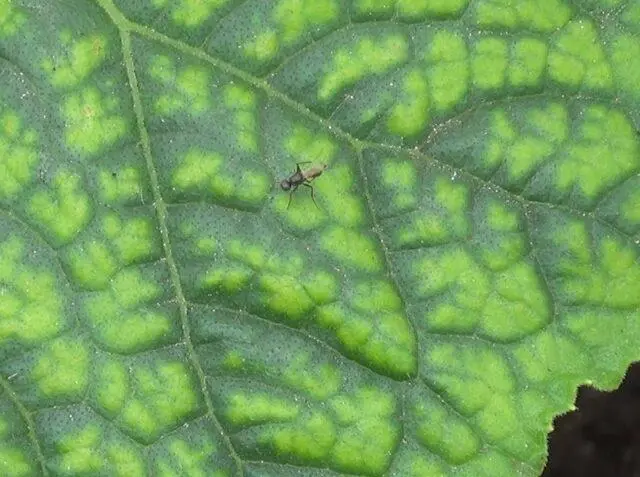
This disease of an infectious type is not subject to treatment.
What can be confused with
Chlorosis can be confused with other diseases of the apple tree. To be able to recognize it, you need to familiarize yourself with their characteristic differences.
Chlorosis can be confused with:
- Mosaic of an apple tree. With this disease, light areas appear on the leaves in the form of spots and stripes. Initially, they have a bright yellow tint, subsequently turn pale, and then necrosis appears. As a result, the affected plates crumble. Mosaic is caused by the Apple mosaic virus. The clarity of the pattern in the disease may vary, depending on the type of strain of the pathogen. Lightened areas with a mosaic appear not only on leaves, but also on shoots, apples. Against the background of the disease, fruiting occurs later, the yield of the apple tree is sharply reduced.

Mosaic virus is transmitted by budding and grafting cuttings
- Chlorotic ring spot. A common disease that manifests itself as light spots on the leaves and dark annular areas on the fruits. The growth of young shoots also slows down. The causative agent is the Apple chlorotic leaf spot virus. The disease begins to develop in the second half of summer. Moreover, the probability of its occurrence in dry seasons increases significantly.

Chlorotic ring spot affects not only apple trees, but also pears, quince
How and how to treat apple leaf chlorosis
As soon as the cause of chlorosis is established, it is necessary to start its treatment. Since the sooner the apple tree receives the missing element, the less harm the disease will cause to the tree.
With iron deficiency
In this case, iron sulfate can be used. This is an affordable tool, but in order for it to give the desired result, you must first convert the necessary component into a chelated or accessible form for the apple tree.
To do this, add citric acid (10 tsp) and ferrous sulfate (5 g) to settled water (25 l). Mix all the ingredients and insist for an hour.
You can prepare an effective remedy according to another recipe. In this case, it will be necessary to dissolve 10 g of ferrous sulfate and 100 g of ascorbic acid in 200 liters of water. Mix all ingredients until smooth. After that, you can use iron sulfate in this form to water apple trees in the garden that suffer from chlorosis.

Iron vitriol enhances the immunity of trees
With nitrogen deficiency
To make up for the missing component, urea or carbamide should be used. To treat chlorosis, add 10 g of fertilizer to 35 liters of water and water the apple tree. If necessary, the procedure should be repeated after ten days.
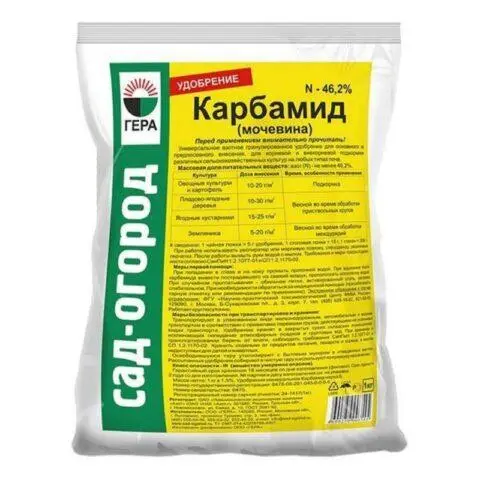
Urea contains over 40% nitrogen
With oxygen starvation
To eliminate this cause of chlorosis, it is necessary to loosen the root circle and add 10-15 kg of rotted organic matter into it, depending on the age of the apple tree. Subsequently, it must be embedded in the ground and water the tree abundantly. This will attract worms to the root circle, which, in the course of their life, form passages, which improves the access of oxygen to the roots.
With a lack of magnesium
Magnesium sulfate helps to fill the deficiency of the element. To prepare the solution, add 20 g of the drug to 10 liters of water and spray the apple tree. The procedure should be repeated 3-4 times per season with a frequency of ten days.

Watering an apple tree with magnesium sulfate will give a result only after a few years.
With a lack of boron
Boric acid helps to correct the situation in this case. For the treatment of chlorosis, it is necessary to prepare a solution at the rate of 5 g of the product per 10 liters of water, and then spray the crown of the tree with it. The procedure is recommended to be carried out before the flowering of the apple tree.

Boric acid improves fruit set
With a lack of potassium and calcium
If there is a shortage of this element, the acidity of the soil should be checked. To reduce it, you need to add 1 kg of wood ash to the root circle, followed by its incorporation into the soil.
If, with a lack of these elements, the acidity is within the normal range, then the apple tree should be fed with calcium sulfate or potassium sulfate. To make up for the deficiency, dissolve 20 g of the drug in 10 liters of water and spray the crown with the resulting product.

Calcium sulfate and potassium quickly eliminates signs of chlorosis
preventive measures
In order not to subsequently have to deal with apple chlorosis, it is necessary to observe simple preventive measures. This is especially important for preventing the viral form of the disease, since, unlike the physiological one, it is impossible to cure it.
Preventive measures:
- Timely treat trees from pests that can be carriers of viral chlorosis.
- Do not plant apple trees in areas where water stagnates.
- Regularly loosen the soil in the root circle and remove weeds that are able to take the necessary nutrients.
- Timely feed the apple tree at least three times per season, add organic matter.
- During hot periods, mulch the topsoil to prevent excessive evaporation.
- Control the level of acidity.
- Keep a distance of at least 3-4 m between trees.
Conclusion
Chlorosis of the apple tree occurs against the background of improper care and inconsistency in the conditions for growing the crop. This disease can not only reduce the yield, but also cause the death of the tree. And only timely control measures can minimize the damage from defeat.










